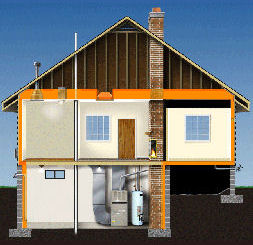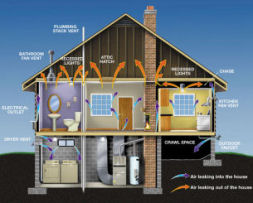ENERGY EFFICIENCY ANALYSIS
Internationally, within last 10-yrs, code officials recognized the need for a modern, up-to-date building code addressing the design and installation of building systems through requirements emphasizing performance. Two codes were established:
The International Residential Code® ( IRC ) and The International Building Code® ( IBC )
The IRC is designed to meet these needs through model code regulations that safeguard the public health and safety in detached one- and two-family dwellings. The IBC is designed to meet these needs through model code regulations that safeguard the public health and safety in all communities, large and small.
These comprehensive building codes, establish minimum regulations for building systems using prescriptive and performance- related provisions. They are devised and regulated by specific codes starting with the International Code Council (ICC) and all they way down to the International Zoning Code.
Energy Conservation - essential part of new construction or renovations
All buildings shall be designed and constructed in accordance with the International Energy Conservation Code. This code establishes minimum prescriptive and performance related regulations for the design of energy efficient buildings and structures or portions thereof.
Minimum code requirements have been established for individual municipalities located within its geographical region, worldwide. Your Code Enforcement Officer will provide you with the Table that you need to comply with at minimum levels. Most of these tables are very stringent and sometimes do not apply to your situation.
In that case, the permitting applicant has an option to provide the Officer of jurisdiction with an Energy Efficiency analysis that is specific for that job. To provide a uniform reporting system to inspecting officials, the U.S. Department of Energy devised a computerized program analysis for the energy efficiency of structures.
Two computerized analysis, developed by Pacific Northwest National Laboratory for the Department of Housing and Urban Development under direction of the U.S. Department of Energy are:
 REScheck, a computerized analysis of Energy Efficiency for up to 2-family residential dwellings.
REScheck, a computerized analysis of Energy Efficiency for up to 2-family residential dwellings. COMcheck, a computerized analysis of Energy Efficiency for commercial buildings.
COMcheck, a computerized analysis of Energy Efficiency for commercial buildings.Energy Efficiency Envelope
Essentially, the Energy Efficiency Envelope is a thermal protection surrounding a dwelling. From foundation to the roof, minimal requirements for thermal protection of heated / cooled spaces within a dwelling must comply with minimum energy conservation requirements. The envelope can be described as thermal protection of surfaces ( shown as "orange outline" in the first image below ) and thermal protection of air due to infiltration ( shown as "arrow direction leaks" in the second image below ).
Basic thermal protection ( losses or gains ) in the Envelope contains:
- Insulation of Footer / Basement Floor
- Insulation of Foundation Walls
- Energy Efficiency of the HVAC System
- Insulation of Walls
- Thermal Efficiency of Windows / Doors
- Insulation of Ceiling
- Attic / Roof Ventilation
- Protection from Air Leaks
How is your Energy Efficiency Envelope?
Inadequate insulation and air leakage are leading causes of energy waste in most homes !
Based on its molecular weight, heat flows naturally from a warmer to a cooler space. In the Winter, the heat moves directly from all heated living spaces towards the outdoor cooler air. During the Summer, heat moves from outdoors towards the interior of the house. To maintain indoor comfort, the heat lost in the Winter must be replaced by your heating system; similarly, the heat gained in the Summer must be tempered by your air conditioner.
Insulation saves money and our nation's limited energy resources, while it makes your home more comfortable by maintaining a uniform temperature throughout.
Insulating your Footer, Basement Floor, Foundation Walls, HVAC System Ductwork, Walls, Ceiling and Attic floor will promote good Energy Efficiency Envelope!
How much is enough ? The more the better ! Once the energy savings have paid for the installation cost, energy conserved is money saved - and saving energy will be even more important as utility rates continually rise.

The ability of insulation to limit air movement should not be confused with air sealing of "cracks" ! The insulation reduces air movement only within the space it occupies. It will not reduce air movement through other cracks within the home.
There is no reason to have those "cracks" bring-in more of the outside air, because every time you open the exterior door is enough to start-up your HVAC system.
Every penetration through the "envelope" should be sealed to prevent infiltration of outside air into your home, thus promoting good Energy Efficiency Envelope!
Of course, the amount of energy you conserve will depend on several factors. Your local climate; the size, shape, and construction of your home; and the living habits of your family.

REScheck and COMcheck Analysis
ANA & Associates has analyzed numerous structures for Energy Efficiency in residential and commercial industries. We will analyze your proposed structure, evaluate the Energy Efficiency Envelope and provide you with a Report that is submitted with your permit application.
Call us, or Click here to request your COMcheck Analysis Report